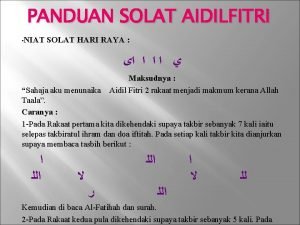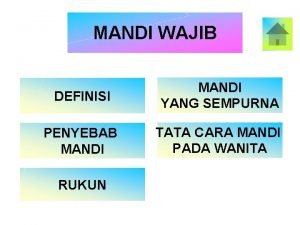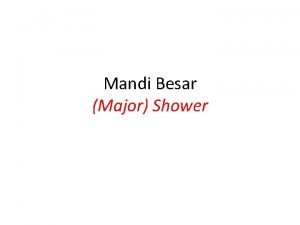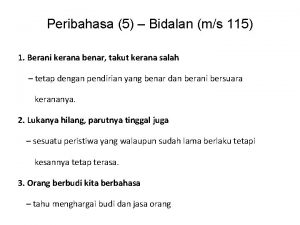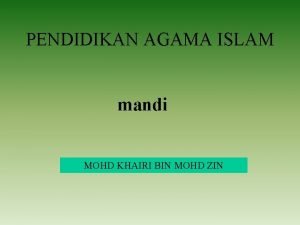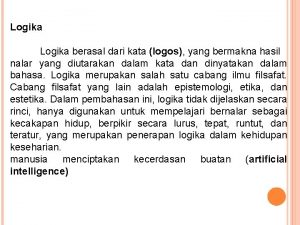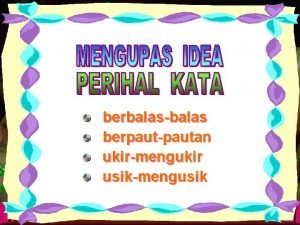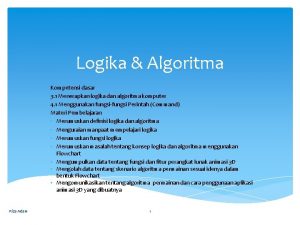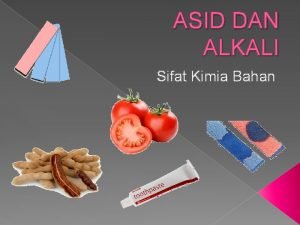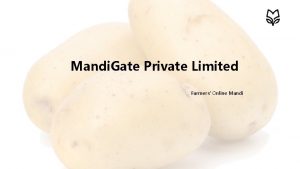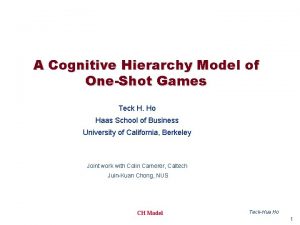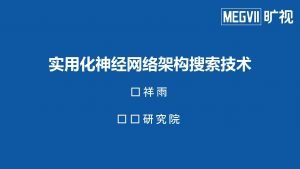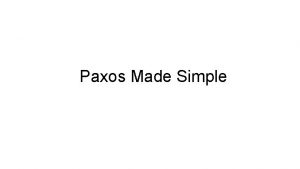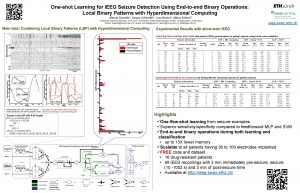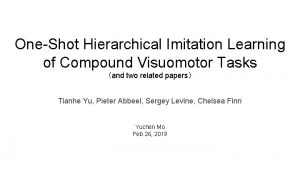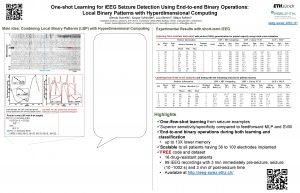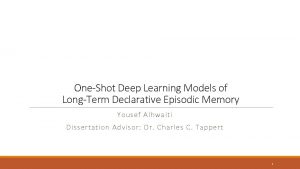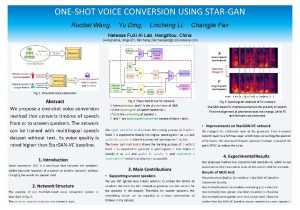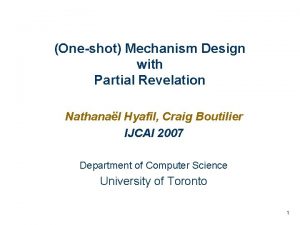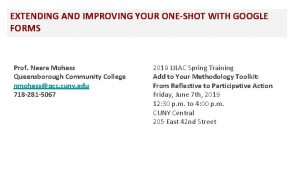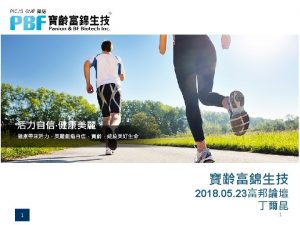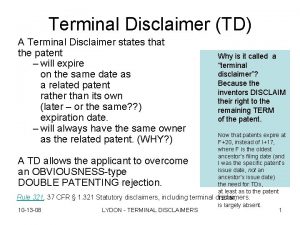Assessment of the OneShot Introduction Disclaimer Mandi Smith







































- Slides: 39

Assessment of the One-Shot

Introduction & Disclaimer • Mandi Smith – Technical and Electronic Services Librarian • Jason Smith – Reference, Archives, and Interlibrary Loan Librarian

Overview • • • Student learning outcomes Aligning outcomes Creating and aligning measures Distributing measures Scoring measures Presenting results to the institution

Student Learning Outcomes • What is a student learning outcome o “Student learning outcomes or SLOs are statements that specify what students will know, be able to do or be able to demonstrate when they have completed or participated in a program/activity/course/project. Outcomes are usually expressed as knowledge, skills, attitudes or values. ” (A Guide to Developing Measurable Student Learning Outcomes, Cañada College – Office of Planning, Research, and Student Services)

Student Learning Outcomes • Student focused Focus on what students are learning, not what librarians are doing.

Student Learning Outcomes • NOT student focused: The librarian will teach search strategies that will improve students’ search results. • Student focused: The student will identify search strategies to improve their search results.

Student Learning Outcomes • Characteristics of Student Learning Outcomes o “Describe what students should be able to demonstrate, represent, or produce based on their learning” o “Rely on active verbs that identify what students should be able to demonstrate, represent or produce” (Tips for Writing Student Learning Outcomes, Indiana University-Purdue University Indianapolis – The Center for Teaching and Learning)

Student Learning Outcomes • Phrasing matters! • Action verbs are more relatable and can be measured • Bloom’s taxonomy o o o Create Evaluate Analyze Apply Understand Remember Higher Order Thinking

Student Learning Outcomes Remembering • • Recognize List Identify Describe Retrieve Name Locate Find Understanding • • Interpret Summarize Infer Paraphrase Classify Compare Explain Exemplify Applying • • • Implement Carry out Use Execute Operate Edit Bloom’s Revised Taxonomy

Student Learning Outcomes Analyzing • • Compare Organize Deconstruct Attribute Outline Find Structure Integrate Evaluating • • Hypothesize Critique Experiment Judge Test Detect Monitor Creating • • • Implement Carry out Use Execute Operate Edit Bloom’s Revised Taxonomy

Student Learning Outcomes

Student Learning Outcomes • Cameron’s Student Learning Outcomes o The student will locate library resources by searching the library catalog or databases. o The student will identify search strategies to improve their search results. o The student will recognize the proper use of citation to avoid plagiarism. o The student will identify the factors making up the authority of a source.

Aligning Outcomes • Cameron’s outcomes were made before the new ACRL Framework was released. o Aligned with what we teach and what we expect our students to learn o Aligned with ACRL Information Literacy Competency Standards for Higher Education o Aligned with the institution’s mission

Aligning Outcomes • Aligning with the ACTUAL instruction • Example o Previous: The student will verbalize positive outcomes associated with using information properly. o Current: The student will recognize the proper use of citation to avoid plagiarism. • Periodically review outcomes to make sure they still align with instruction.

Aligning Outcomes

Aligning Outcomes • Aligning with the new ACRL Framework o Can use the knowledge practices and dispositions as foundation of student learning outcomes

Aligning Outcomes • Knowledge Practices • Use different searching language types (e. g. , controlled vocabulary, keywords, natural language) • Give credit to the original ideas of others through proper attribution and citation • Use various research methods, based on need, circumstance, and type of inquiry • Dispositions can also be used to generate ideas even though they are more abstract and harder to measure o Value the process of matching an information need with an appropriate product

Aligning Outcomes “Neither the knowledge practices nor the dispositions that support each concept are intended to prescribe what local institutions should do in using the Framework; each library and its partners on campus will need to deploy these frames to best fit their own situation, including designing learning outcomes. For the same reason, these lists should also not be considered exhaustive. ” (ACRL Board of Directors Action Form, January 16, 2015)

Aligning Outcomes • Cameron’s outcome: The student will identify search strategies to improve their search results. • ACRL Frame: Searching as Strategic Exploration Searching for information is often nonlinear and iterative, requiring the evaluation of a range of information sources and the mental flexibility to pursue alternate avenues as new understanding develops.

Creating & Aligning Measures • What is a measure? o Anything that measures the outcome. It can be as long as a portfolio or as short as a single multiple choice question. • Since we are assessing the one-shot we focused on short measures. • Additionally we only used one or two measures per outcome.

Creating & Aligning Measures Example • Outcome: The student will identify the factors making up the authority of a source.

Website Authority Question 1: Please list three factors that make a source authoritative. Question 2: Please circle two items on the provided website that make it authoritative, and explain why they do so.

Creating & Aligning Measures • Important that the outcomes are valid and reliable. • Valid - measuring accurately • Reliable – measuring consistently • HARDEST PART!!

Creating & Aligning Measures • Tips o Don’t lose sight of what you are measuring. o When possible use the same phrasing as the outcome. o Ask a knowledgeable outsider to verify that the measure aligns with the outcome; this will help to establish face validity o Test and, if need be, modify the measures

Creating & Aligning Measures Example • Outcome: The student will identify search strategies to improve their search results. • Measure: Please list two search strategies that can improve your results.

Creating & Aligning Measures • √ Use multiple keywords • √ Use advanced search • √ Filter your results using dates and formats • Use a narrower or broader term √ Expectations

Creating & Aligning Measures • √ Catalog • √ Academic Search Premier • √ EBSCO • √ Google Reality

Creating & Aligning Measures The fix: • Previous Measure: Please list two search strategies that can improve your results. • Current Measure: Please list two search strategies that can improve your results when searching in the CU catalog and/or databases.

Distributing Measures • History o Previously pre-test and post-test o Cameron went to a 4 -day class schedule o Only get to teach a one-shot information literacy session as opposed to the two sessions we taught in the past o Used surveys asking students how much they improved, but IAC asked for direct measures So…

Distributing Measures • One-shot Measures o Made a conscious decision to not spend more than 5 minutes on assessment during each one-shot session o DO NOT attempt to measure every outcome during each session o Focused on program assessment versus a single class session o Each session measure one or at most two outcomes o Focus on the lower end of Bloom’s taxonomy

Scoring Measures • Grading o Two librarians graded each set of questions separately o When needed, a third librarian was the tiebreaker

Scoring Measures • Rubrics o Pass/fail and multiple choice (get 2 or more answers right) o Discussed beforehand what would be acceptable answers to improve inter-rater reliability o Liberal but somewhat strict in what we accepted as correct answers (ex. Google Scholar was ok but not Google as a search strategy)

Scoring Measures

Scoring Measures Pass Jason Pass Fail Total Proportion of observed agreement: =(C 3+D 4)/E 5 Expected proportion of agreement: =((C 5*E 3)+(D 5*E 4))/(E 5*E 5) Kappa: =(B 8 -B 9)/(1 -B 9) PABAK: =(2*B 8)-1 Prevalence index: =(C 3 -D 4)/E 5 Bias index: =(D 3 -C 4)/E 5 Proportion of positive agreement: =(2*C 3)/(E 5+C 3 -D 4) Proportion of negative agreement: =(2*D 4)/(E 5 -C 3+D 4) 22 4 =C 3+C 4 0. 719298245614035 0. 491535857186827 0. 447941888619855 0. 43859649122807 0. 0526315789473684 0. 140350877192982 0. 73333333 0. 703703704 Barbara Fail 12 19 =D 3+D 4 Total =C 3+D 3 =C 4+D 4 =E 3+E 4

Presenting the Results

Presenting the Results

Presenting the Results

Questions ? ? ?

Reference Links • http: //www. niu. edu/facdev/programs/handouts/blooms. sh tml • https: //www. canadacollege. edu/inside/research/slos/doc uments/STUDENT%20 SERVICES%20 SLO%20 GUIDE %20 BOOK. pdf • http: //ctl. iupui. edu/Resources/Planning-the-Learning. Experience/Writing-Student-Learning-Outcomes
 Niat sembahyang aidilfitri
Niat sembahyang aidilfitri Mandi hadas
Mandi hadas Rukun mandi wajib
Rukun mandi wajib Coy amina show
Coy amina show Fungsi acropolis dalam tamadun yunani
Fungsi acropolis dalam tamadun yunani Ayat bidalan
Ayat bidalan Mandi wajib
Mandi wajib Denah kamar mandi
Denah kamar mandi Logika berasal dari kata ….
Logika berasal dari kata …. Home industri sabun mandi
Home industri sabun mandi Contoh bina ayat bersalaman
Contoh bina ayat bersalaman Logika berasal dari kata λόγος (logos) yang bermakna
Logika berasal dari kata λόγος (logos) yang bermakna Nasi asid atau alkali
Nasi asid atau alkali Syarat wajib solat jenazah
Syarat wajib solat jenazah Arti kashyap iit mandi
Arti kashyap iit mandi Hát kết hợp bộ gõ cơ thể
Hát kết hợp bộ gõ cơ thể Lp html
Lp html Bổ thể
Bổ thể Tỉ lệ cơ thể trẻ em
Tỉ lệ cơ thể trẻ em Voi kéo gỗ như thế nào
Voi kéo gỗ như thế nào Tư thế worm breton là gì
Tư thế worm breton là gì Chúa sống lại
Chúa sống lại Môn thể thao bắt đầu bằng chữ f
Môn thể thao bắt đầu bằng chữ f Thế nào là hệ số cao nhất
Thế nào là hệ số cao nhất Các châu lục và đại dương trên thế giới
Các châu lục và đại dương trên thế giới Công thức tiính động năng
Công thức tiính động năng Trời xanh đây là của chúng ta thể thơ
Trời xanh đây là của chúng ta thể thơ Cách giải mật thư tọa độ
Cách giải mật thư tọa độ Làm thế nào để 102-1=99
Làm thế nào để 102-1=99 Phản ứng thế ankan
Phản ứng thế ankan Các châu lục và đại dương trên thế giới
Các châu lục và đại dương trên thế giới Thể thơ truyền thống
Thể thơ truyền thống Quá trình desamine hóa có thể tạo ra
Quá trình desamine hóa có thể tạo ra Một số thể thơ truyền thống
Một số thể thơ truyền thống Cái miệng nó xinh thế chỉ nói điều hay thôi
Cái miệng nó xinh thế chỉ nói điều hay thôi Vẽ hình chiếu vuông góc của vật thể sau
Vẽ hình chiếu vuông góc của vật thể sau Thế nào là sự mỏi cơ
Thế nào là sự mỏi cơ đặc điểm cơ thể của người tối cổ
đặc điểm cơ thể của người tối cổ Ví dụ giọng cùng tên
Ví dụ giọng cùng tên Vẽ hình chiếu đứng bằng cạnh của vật thể
Vẽ hình chiếu đứng bằng cạnh của vật thể
